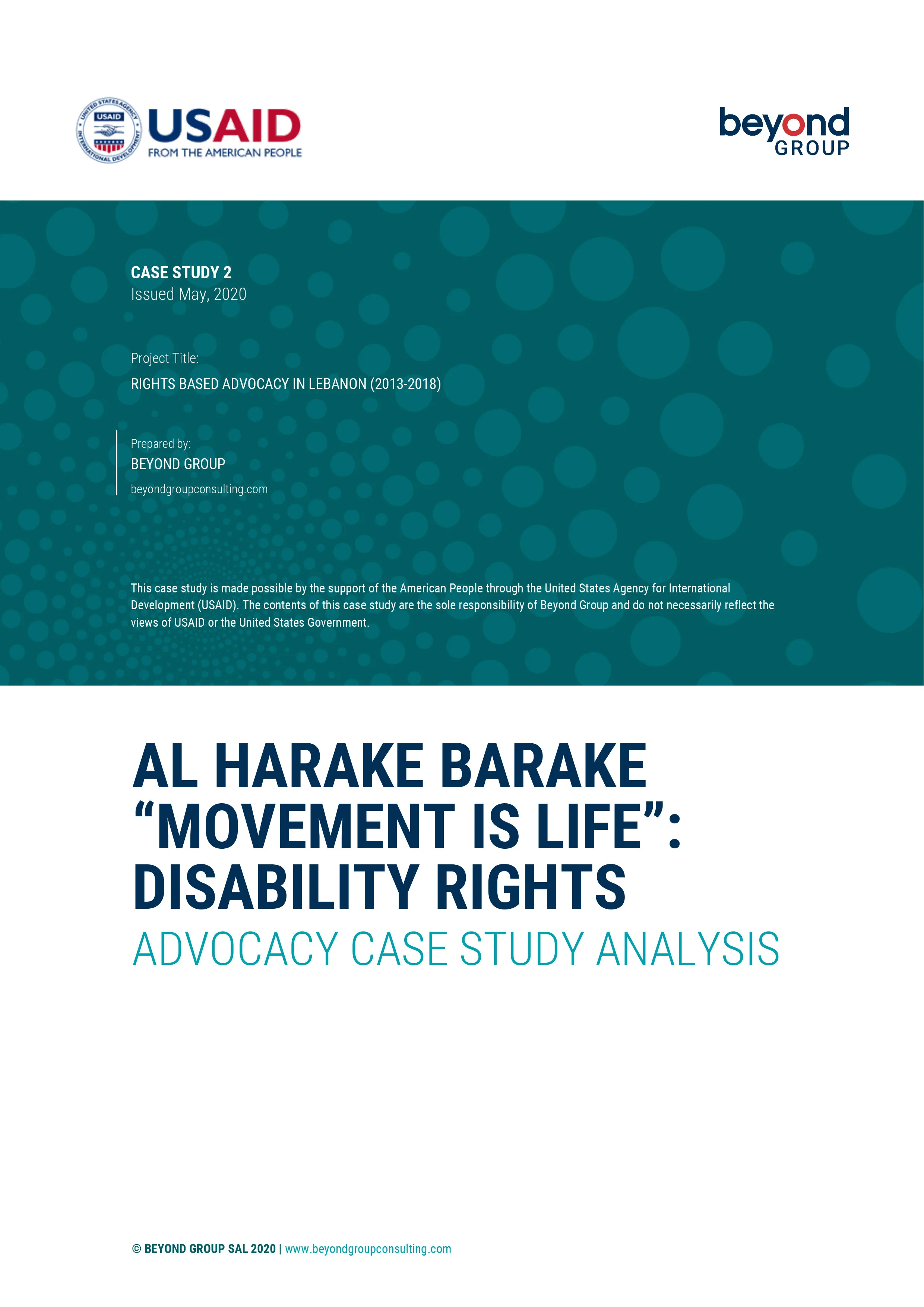“Movement Is Life”: Disability Rights
Developed By:
Beyond Group
In Partnership With:
Counterpart International
2020
AL HARAKE BARAKE “MOVEMENT IS LIFE”: DISABILITY RIGHTS
Advocacy Case Study Analysis
CASE STUDIES IN LEBANESE CIVIL SOCIETY ADVOCACY
Within the framework of the USAID Baladi CAP project, Counterpart International supported a research project on civil society advocacy in Lebanon, with the goal of broadening the democratic space for citizen participation in public affairs by creating platforms for informed public debate and increased citizen engagement outside of sectarian and confessional lines. Selected through an open competition, BRD undertook a mapping of advocacy campaigns in Lebanon 2013-18 and together with Counterpart developed five case studies in an effort to highlight best practices and common factors contributing to civil society advocacy’s success or failure and enhancing an understanding of the needs of CSOs working on advocacy to further advance rights and reform in Lebanon.
CASE STUDY CAMPAIGN ISSUE AND CONTEXT
The document of the National Accord which was signed on October 22, 1989 in Taif city in the Kingdom of Saudi Arabia, by the living members of the 1972 parliament, brought an end to 15 years of the Lebanese Civil War. Without reconciliation amongst its people, the country was in full operation again and government institutions took shape and started functioning normally.
However, with the assassination of former Prime Minister Rafiq el Hariri on February 14, 2005 and allegations pointing at the Syrian regime and Hezbollah, the country yet again got divided vertically. The hate instigating discourses and the political division continued to intensify until May 7, 2008 when it took a violent route on the streets of Beirut between Hizbollah and the Future Movement. Sunni groups in Tripoli reacted few days after, May 10 in particular, and the Alawite Jabal Mohsen, Hezbollah’s ally in the city, was attacked leading to few casualties and injuries among the residents. This attack marked the first in a series of 22 rounds of clashes between the Sunni areas of Bab El Tabbaneh, Qobbe, and Baddawi from one side and the predominantly Alawite Jabal Mohsen from another.
These clashes were again exacerbated in 2011 by the war in Syria as groups got divided again between those supporting the Syrian regime and those against it, translating these positions into a show of force on the ground. This in turn, led to an increase in the intensity of the clashes leaving more destruction and casualties among the two sides.
On April 1, 2014 the Government of Lebanon (GoL) headed by Prime Minister Tammam Salam started implementing a security plan in Tripoli putting an end to the numerous rounds of clashes and returning normalcy to the city. The clashes have left behind hundreds of families living in an extremely dire economic situation and increased the number of disabled individuals living in the city. Although this security plan has brought calm to the city, it did not yet bring much focus of development work to neither the economic nor the social levels.
To complement the security apparatus, local civil society activists and NGOs started carrying out rehabilitation projects, community activities, and advocacy actions to look into enhancing the basic conditions of the people living in the city and promote their engagement in a long term reconciliation process.
A MOVEMENT EMERGES FOR DISABILITY RIGHTS
During the conflict analysis research conducted as part of “The Roadmap to Reconciliation in Tripoli (RRT)” which was later complemented by another conflict assessment done for the UNDP Peacebuilding Program, activists and NGOs under the RRT came to a realization that the most recurrent concern from the people they interviewed and met with (over 35), focused on people who were severely injured following the clashes in Tripoli. This information was validated by representatives and local staff of the Ministry of Social Affairs (MOSA) in Tripoli, the official institution responsible for caring for individuals with disabilities (including people with disabilities injured during the clashes), who confirmed that the category including individuals injured and/or disabled from the clashes are among the most vulnerable and impoverished living in the city.
Therefore, addressing the rights of people with disabilities as a cause became an integral component of the efforts aiming to launch a grassroots reconciliation process by the RRT partners and supported by both UNDP and MOSA. This was when the efforts to create a joint Sunni-Alawite committee of individuals physically disabled as a result of the clashes to advocate for the rights of all their peers was launched, which was later called Al Harake Barake (Movement is Life).
Al Harake Barake evolved into a local advocacy campaign calling for the rights of the people who were physically affected by the conflict in Tripoli. This case study was chosen among selected campaigns as it brings forward several lessons learned around:
Partnerships with government for advocacy
Engaging the affected people directly in the campaign
Linking local efforts to national ones
Ensuring cohesion among a group of former rivals
Engaging the most vulnerable community members in structured and organized advocacy work
Building a comprehensive evidence-based advocacy case and the usage of data

